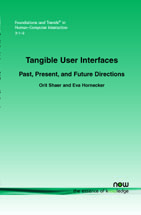Tangible User Interfaces: Past, Present, and Future Directions
By Orit Shaer, Wellesley College, USA, oshaer@wellesley.edu | Eva Hornecker, University of Strathclyde, UK, eva@ehornecker.de
Abstract
In the last two decades, Tangible User Interfaces (TUIs) have emerged as a new interface type that interlinks the digital and physical worlds. Drawing upon users' knowledge and skills of interaction with the real non-digital world, TUIs show a potential to enhance the way in which people interact with and leverage digital information. However, TUI research is still in its infancy and extensive research is required in order to fully understand the implications of tangible user interfaces, to develop technologies that further bridge the digital and the physical, and to guide TUI design with empirical knowledge.
This monograph examines the existing body of work on Tangible User Interfaces. We start by sketching the history of tangible user interfaces, examining the intellectual origins of this field. We then present TUIs in a broader context, survey application domains, and review frameworks and taxonomies. We also discuss conceptual foundations of TUIs including perspectives from cognitive sciences, psychology, and philosophy. Methods and technologies for designing, building, and evaluating TUIs are also addressed. Finally, we discuss the strengths and limitations of TUIs and chart directions for future research.
Tangible User Interfaces
Tangible User Interfaces (TUIs) have emerged as a new interface type that interlinks the digital and physical worlds. Drawing upon users' knowledge and skills of interaction with the real non-digital world, TUIs show a potential to enhance the way in which people interact with and leverage digital information. However, TUI research is still in its infancy and extensive research is required in order to fully understand the implications of tangible user interfaces, to develop technologies that further bridge the digital and the physical, and to guide TUI design with empirical knowledge. Tangible User Interfaces: Past, Present and Future Directions surveys this rich and diverse field of research. It evaluates the existing body of knowledge with respect to designing, implementing, and evaluating TUIs, highlighting perspectives from human-computer interaction, design, engineering, psychology and cognitive sciences. It concludes with a discussion on the strengths and limitations of TUIs and charts directions for future research.
